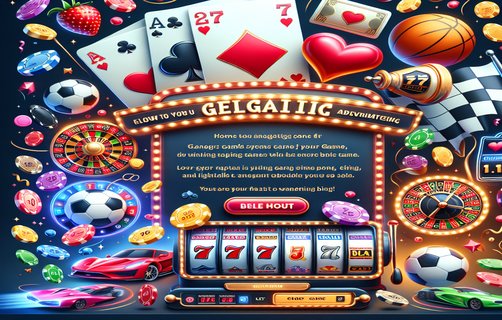Mastering Live Poker: Strategies for Long-Term Success
जीवित पोकर में महारत: दीर्घकालिक सफलता के लिए रणनीतियाँ
In the world of poker, especially in live settings, aspiring players often find themselves juggling multiple strategies, managing their bankroll, and adapting to unpredictable opponents. To thrive in this competitive arena, establishing a long-term target focus is essential. This approach requires clarity in defining one’s poker goals, whether it be increasing a bankroll over a specified period, mastering a particular game type, or even entering major tournaments. Setting these objectives not only provides motivation but also helps in recalibrating one’s strategy as necessary.
Once a long-term focus is established, the next essential component is amount planning. This involves determining how much capital you are willing to invest and how much you can risk in each session. Understanding variance is crucial here. It’s all too common for players to experience swings, and having a solid amount planning strategy will ensure that negative streaks don’t derail your overall financial stability. Determine your stake levels based on your bankroll – a common recommendation is not to risk more than 1-5% of your bankroll in a single game.
Errors in stake level are another common pitfall in poker. Many players tend to jump into games with stakes that are either too high or too low for their skill level. To avoid stake errors, analyze your playing style and comfort with risk. Engage in regular self-assessment, taking an honest look at how your bankroll correlates with your skill and emotional stability. It’s crucial to remain disciplined and stick to your predefined limits while avoiding the temptation to chase losses.
In pursuit of strategic profit methods, players can adopt various strategies, including differential betting, player profiling, and game selection. Differential betting involves adjusting your bet sizes based on the strength of your hand, your opponent's tendencies, and the game dynamics. Meanwhile, profiling opponents can give you insights into their behaviors, allowing you to capitalize when they make mistakes.

A well-structured stake adjustment plan is vital for navigating different playing conditions. When faced with a challenging table, consider reducing your stakes or temporarily switching to a less volatile game format. Conversely, if you identify an opportunity in a weaker player pool, do not hesitate to increase your stakes to maximize potential returns. Your stake adjustment should always reflect both your confidence and the specific characteristics of the game landscape you’re operating within.

Pace adjustment strategies are also paramount in live poker. The tempo of a game can swing from intense action to slow deliberation, and adapting your play style accordingly is vital. If the table is tight and players are folding frequently, aggressive betting could yield favorable results. Conversely, in a loose environment, conservative play might help to exploit other players’ mistakes effectively. Recognizing these shifts and adjusting your betting patterns accordingly will give you an edge.
In summary, mastering live poker requires a multifaceted approach, balancing long-term focus, careful planning, and strategic adaptation to varying conditions. By committing to a structured framework that emphasizes these elements, players can elevate their game and increase their potential for sustained success at the tables.
जीवित पोकर की दुनिया में, विशेष रूप से जीवंत सेटिंग में, उभरते खिलाड़ियों को अक्सर कई रणनीतियों को संभालते हुए, अपने बैंक रोल का प्रबंधन करते हुए और अप्रत्याशित प्रतिस्पर्धियों के अनुकूल होते हुए पाया जाता है। इस प्रतिस्पर्धात्मक क्षेत्र में फलने-फूलने के लिए, दीर्घकालिक लक्ष्यों पर ध्यान केंद्रित करना आवश्यक है। यह दृष्टिकोण आपके पोकर लक्ष्यों को परिभाषित करने में स्पष्टता की आवश्यकता है, चाहे वह एक निर्दिष्ट समयावधि में बैंक रोल को बढ़ाना, किसी विशेष खेल प्रकार में महारत हासिल करना, या यहां तक कि प्रमुख टूर्नामेंट में प्रवेश करना हो। इन उद्देश्यों को निर्धारित करना न केवल प्रेरणा प्रदान करता है बल्कि आवश्यकतानुसार रणनीति को पुनः कैलिब्रेट करने में भी मदद करता है।
एक बार जब दीर्घकालिक ध्यान स्थापित हो जाता है, तो अगला आवश्यक घटक है राशि नियोजन। इसमें यह निर्धारित करना शामिल होता है कि आप कितनी पूंजी को निवेश करने के लिए तैयार हैं और आप प्रत्येक सत्र में कितनी जोखिम उठा सकते हैं। यहां विविधता को समझना महत्वपूर्ण है। खिलाड़ियों के लिए झूलों का अनुभव करना बहुत सामान्य है, और एक ठोस राशि नियोजन रणनीति यह सुनिश्चित करेगी कि नकारात्मक धाराएं आपकी कुल वित्तीय स्थिरता को बाधित न करें। अपने बैंकroll के आधार पर अपनी स्टेक स्तरों का निर्धारण करें – सामान्य सिफारिश है कि आप एक ही खेल में अपने बैंकroll का 1-5% से ज्यादा जोखिम न लें।
स्टेक स्तरों में त्रुटियाँ पोकर में एक और सामान्य फंदे हैं। कई खिलाड़ी उस खेल में कूदने की प्रवृत्ति रखते हैं जिनकी स्टेक उनकी कौशल स्तर के लिए बहुत ऊंची या बहुत नीची होती है। स्टेक त्रुटियों से बचने के लिए, अपने खेलने के तरीके और जोखिम के साथ अपनी निरंतरता का विश्लेषण करें। नियमित आत्म-मूल्यांकन में संलग्न हों, यह ईमानदारी से देखें कि आपका बैंकroll आपके कौशल और भावनात्मक स्थिरता के साथ कैसे संबंध रखता है। यह महत्वपूर्ण है कि आप अनुशासित रहें और अपने पूर्वनिर्धारित सीमाओं के भीतर रहें जबकि हानि पाने के लिए आत्मप्रेरणा से बचे रहें।
रणनीतिक लाभ विधियों की दिशा में, खिलाड़ी विभिन्न रणनीतियों को अपना सकते हैं, जैसे कि विवर्तनात्मक सट्टेबाजी, खिलाड़ी प्रोफाइलिंग, और खेल चयन। विवर्तनात्मक सट्टेबाजी में, आपके हाथ की ताकत, आपके प्रतियोगियों की प्रवृत्तियों और खेल के गतिशीलता के आधार पर आपके सट्टेबाजी के आकार को समायोजित करना शामिल है। इसी तरह, प्रतिस्पर्धियों का प्रोफाइल करना आपको उनके व्यवहारों पर अंतर्दृष्टि देता है, जिसके परिणामस्वरूप आप गलतियाँ करने पर लाभ उठाने में सक्षम होते हैं।
एक अच्छी तरह से संरचित स्टेक समायोजन योजना विभिन्न खेलने की परिस्थितियों को नेविगेट करने के लिए बहुत जरूरी है। जब आप एक चुनौतीपूर्ण टेबल का सामना करते हैं, तो अपनी स्टेक कम करने या अस्थायी रूप से कम अस्थिर खेल प्रारूप में स्विच करने पर विचार करें। इसके विपरीत, यदि आप कमजोर खिलाड़ियों की पूल में एक अवसर पहचानते हैं, तो अपनी संभावित रिटर्न को अधिकतम करने के लिए अपने स्टेक बढ़ाने में संकोच न करें। आपकी स्टेक समायोजन हमेशा आपके आत्मविश्वास और उस विशेष विशेषताओं को व्यक्त करना चाहिए जिसमें आप काम कर रहे हैं।
गति समायोजन रणनीतियाँ भी जीवित पोकर में महत्वपूर्ण हैं। एक खेल के गति तीव्र क्रिया से धीरे-धीरे विचारशीलता की ओर बदल सकती है, और आपके खेलने के तरीके को तदनुसार अनुकूलित करना महत्वपूर्ण है। यदि टेबल टाईट है और खिलाड़ी बार-बार फोल्ड कर रहे हैं, तो आक्रामक सट्टेबाजी लाभकारी परिणाम दे सकती है। इसके विपरीत, एक ढीली पर्यावरण में, सतर्क खेल अन्य खिलाड़ियों की गलतियों का लाभ उठाने में मदद कर सकता है। इन परिवर्तनों को पहचानने और तदनुसार अपना सट्टेबाजी पैटर्न समायोजित करने से आपको एक बढ़त मिल जाएगी।
संक्षेप में, जीवित पोकर में महारत हासिल करने के लिए एक बहुपरक दृष्टिकोण की आवश्यकता होती है, जिसमें दीर्घकालिक ध्यान, संवेदनशील योजना, और विभिन्न परिस्थितियों के प्रति रणनीतिक समायोजन का संतुलन शामिल है। इन तत्वों पर जोर देने वाले एक संरचित ढांचे के प्रति प्रतिबद्ध होकर, खिलाड़ी अपने खेल को ऊंचा कर सकते हैं और तालों पर निरंतर सफलता की संभावनाओं को बढ़ा सकते हैं।

comments
PokerGuru99
These strategies are a game-changer for my live poker sessions. Can't wait to implement them!
ChipMaster77
Amount planning really resonated with me. I always struggle with bankroll management.
BluffQueen23
The pace adjustment strategies are so insightful! It's all about reading the table.
AllInJack
Love the focus on stake errors! It's a pitfall many players fall into.
RiverCardPro
Great analysis! I wish I had these strategies when I started.
FoldEmAll
Looking forward to trying out the differential betting technique!